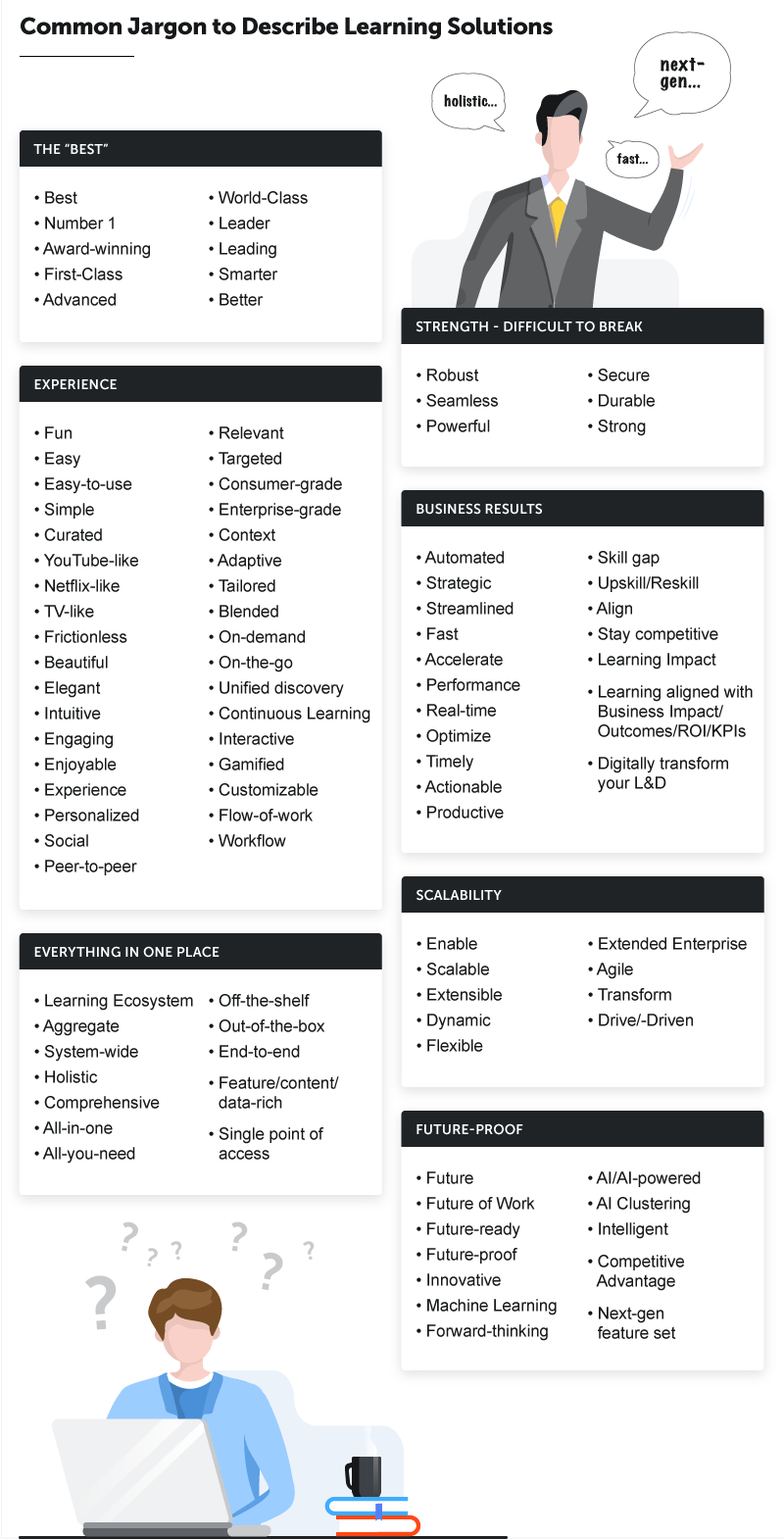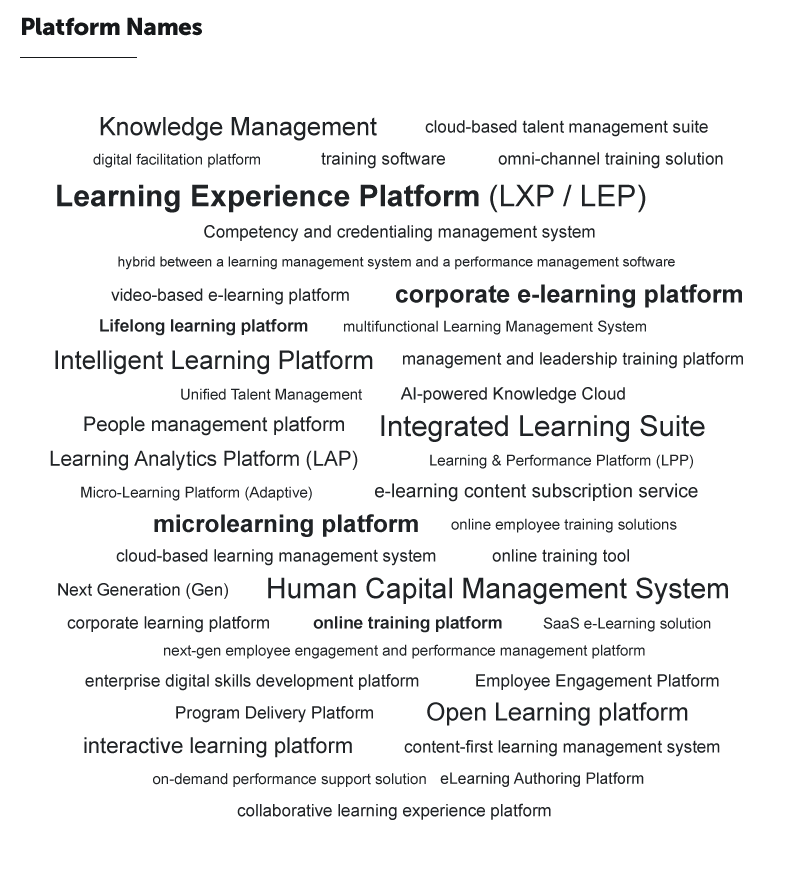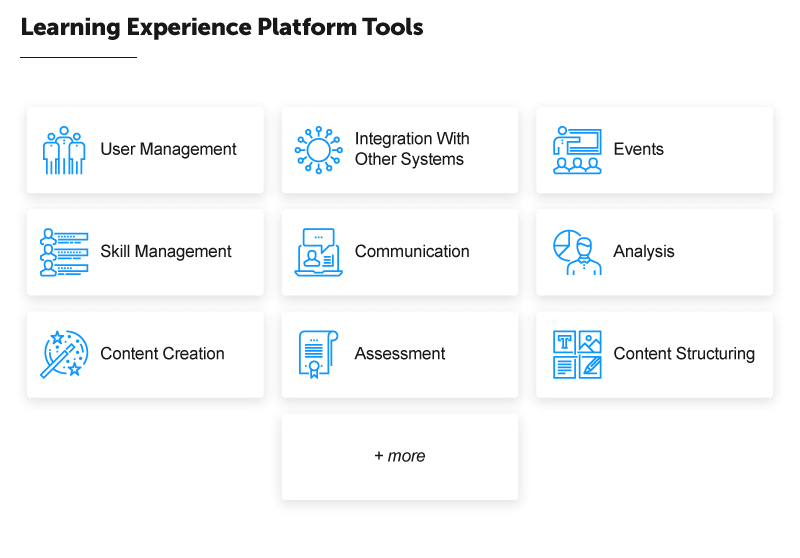Beyond the buzzwords: how to find a Learning Platform
The learning technology market is crowded and overfilling with jargon. How do you deal with buzzwords and choose the right learning platform?

“I’d like to push the envelope, go the extra mile, and think outside the box to facilitate a win-win solution to the over-utilization of buzzwords.” — a Dan Reynolds cartoon
The learning technology market is riddled with buzzwords and jargon, saturated with technology options, and fatigued by features; the end result is buyer confusion.
Jargon can be a form of precise and effective communication by a specialized group, or it can be an exclusive language with unintelligible gibberish.
In a market filled with noise, how can we help buyers evaluate different solutions so they can make the best choice for their organization? First, let’s get beyond the buzzwords. If you are looking for learning technology, you will most likely come across these buzzwords and themes:

As an organization communicating about learning technology, we also can’t escape some of the many words perpetuated by our field when describing functionality, because sometimes the words are the best fitting piece of human language to express; sometimes it is valuable to use them. The main issue is sometimes these words are used, overused, or defined inconsistently to typically over-exaggerate value, and can result in confusion.
Not only is the way we describe the solutions and functionality being misunderstood, but there are tons of different solutions on the market, with different platform names, and little to categorically distinguish them.

Overcoming jargon & overchoice
Overchoice, also known as Choice Overload is a psychological cognitive process to define this phenomenon, in which people have a difficult time making a decision when faced with many options.
Many different factors may contribute to perceived choice overload, including the number of options and attributes, time constraints, decision accountability, alignability and complementarity of options, preference uncertainty, among other factors (Chernev et al., 2015).
Overchoice + overpromise = buyer remorse
Overchoice in the learning technology buyer process can result in choosing a solution that doesn’t sufficiently solve the unique challenges of the organization, and provide measurable value that outweighs the costs of the investment.
Buyers are faced with a sea of options with similar features, confusing and weightless terminology with directions leading down the rabbit hole and paradox of choice.
Choosing the right learning platform comes down to the specific challenges you are facing, and the goals set forth by your organization. Sounds simple enough, but it is anything but simple.
The top challenges in L&D
After collecting hundreds of responses from people looking for learning solutions, we have found that the top challenges facing organizations looking for a learning experience platform can be grouped into 5 main categories:
Lacking an all-in-one / simple solution
- Too many systems including multiple LMS systems and various content libraries.
- Too many different sources for learning content.
- Contents are all over so they need a platform to tie it together and track the learning.
- Different processes and complication working with several different vendors.
- No centralized platform to train the agents and clients.
- Poor flexibility with integrations.
- No single source of learning in business.
- They don’t have a tool in place that can facilitate everything that they want.
Poor experience (for the admin & user)
- Poor learner experience / bad UX.
- Poor administrative experience.
- Difficult to administer.
- The interface is outdated/old.
- Scattered workflows.
- Difficult for learners to find what they need as the company grows.
- They spend a ton of time training their learners. They want to find a faster/easier way to do this.
- They need to be able to train people with microlearning, quickly, regardless of the time and place, and also through mobile devices.
- Low adoption, especially from field workers who need a mobile-friendly interface.
- They have a number of different homegrown systems for different trainings.
- They have several different groups that need training: External and Internal Teams: skill development and compliance.
- eComm – selling training to customers.
- Want to facilitate longer training paths (ie 6-week onboarding program) in a really easy to follow/unintimidating way for learners.
- Need soft skills training and compliance training.
- “Clunky enterprise platform”.
- The learning experience on their current platform is not good and people are not interested due to that.
- No personalization.
- Struggling to cater to all audiences. The current system is not set up for remote workers and there is a desire to move much more to digital. Currently, they are 90% face to face. the workforce is geographically spread.
- All the training is done in classrooms so people have to travel from all over the world to do in-person training.
- No structure to learning.
- Easy submission of assignments.
- Technical difficulties.
- Lots of manual work included.
- No way to store documents.
- LMS lacking basic functionalities.
- Lack of branding.
- Need better blended learning tools.
- Old fashioned systems.
- Delivering learning material on PPT’s.
- Users might have technology aversion & bad English skills. Language versions of lessons is an issue.
- All of their training material has started to look alike.
- Need a stable solution.
- Reliance on classroom trainings that offer no flexibility, no online trainings, not measurable.
- Terrible support.
Inability to measure impact (reporting/tracking/analytics)
- Cannot get the data that they need from it.
- No reporting.
- No metrics/analytics.
- No way to identify the strengths and weaknesses of the teams.
- No ability to measure.
- Need training & competence management – being compliant and efficiently improving & increasing know-how.
- The online content that they do have is not in a trackable system, so they cannot monitor self-paced learning.
- Currently, all training is done through sessions and there’s no way to track anyone’s learning in any way.
- Sales overpromise.
- Need to fulfill compliance requirements.
- Poor reporting capabilities, manually requesting feedback from learners now.
- We don’t get enough valid data out of the LMS.
- Severe lack of reporting capabilities.
Costs & time
- They’re spending a lot of time training in person. There is a lot that can be completed online/self-paced. Want to move to a more self-paced, adaptive platform that can serve up the right info to the right people.
- high cost – paying for content hosting costs on top of LMS
- Right now, most of their training is done in person, which is extremely costly and time-consuming because their learners are spread out globally.
- Want to become more efficient to save time and money.
- Low L&D headcount.
- Long onboarding time = expensive.
- Lack of budget.
- Lack of employee knowledge – Low employee retention.
Scalability
- Also, it’s not scalable as you need more trainers to have more training sessions.
- Poor flexibility in general.
- The current delivery method for e-learning is not scalable.
- They don’t have adequate know-how and experts to implement data science technologies by themselves.
- Learning platform company went through a merger, now things have changed.
Additionally, when we surveyed a total of 2112 responses from over 20 different industries from all job roles (entry-level to C-Level executives) in the United States, Finland, and Germany and we found that the top 3 challenges for learning and development are:
- Lack of time
- Lack of money
- Lack the right tools

If we analyze this data side-by-side, we can consolidate the findings into:
The market need is a solution that provides the the right tools to track, measure and prove a positive return value on their learning platform investment.
How do you find the right learning solution?
As Theodore Levitt said, “People don’t want to buy a quarter-inch drill. They want a quarter-inch hole!”
In the learning technology sector, there are hundreds of quarter-inch drills, but can they successfully drill a quarter-inch hole?
Learning platforms however are more complex solutions to more complex problems; learning platforms are more of learning toolboxes rather, with many tools to help you create, display, and manage your learning. The complexity of learning platforms combined with the pace of the market need, are two reasons the market has become confusing for buyers.

4 Quick tips to find the right solution
- Focus on your challenges or (measurable) goals you want to accomplish
- Know why solving these challenges or achieving these goals will help your business
- Breakdown buzzwords and evaluate learning solutions based on their proven* capacity to help you with 1 and 2
- Choose a transparent vendor that will grow with you, because not all problems of the future will be known today




